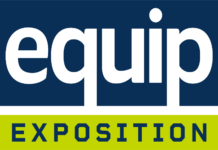Couldn’t make it to GIE+EXPO this year? We’ve got you covered. The editors of Turf Magazine are on the ground, covering everything you need to know at the show. At the end of the day, our editors come together and curate the top moments from the busy day’s events — from announcements at press conferences to inspiring advice from educational sessions. Here are some of the top moments from the first two days of the show.
1. Hot Hardscape Trends
Wondering what your clients are looking for in 2018 hardscapes? Here are 3 trends Rebecca Hughes with Natural Paving shared at GIE+EXPO:
- Gray and tan colors in natural stone are still very popular because they look natural and classic, matching many house shades and styles.
- Connecting indoor and outdoor flooring and patio spaces is a trend to more seamlessly connect the areas visually.
- Natural stone pavers are still popular for customers looking for that weathered, earthy look versus something more forced like concrete.
2. What Your Customers Think
The National Association of Landscape Professionals’ Missy Henriksen shared some statistics from their latest residential customer survey at the GIE+EXPO. Some numbers to note:
- 76% of homeowners think the landscape industry is trustworthy.
- 67% of homeowners think the landscape industry is necessary.
- 62% of homeowners think the landscape industry is environmentally friendly.
- 40% of homeowners say they have used a landscape and lawn care specialist in the last 12 months.
- Why do homeowners choose to use a landscape professional: 62% want their yards to look better, 41% say using a landscape professional’s services saves them time, 30% want to enjoy their outdoor spaces and 12% think the work landscapers are doing is great for the environment.
3. Top 7 Ways to Crush Your Business Goals
GIE+EXPO and NALP’s LANDSCAPES’ session “Scale Like a Shark! Learn More. Earn More,” industry consultant Judy Guido said following these seven tips will help you crush your business goals:
- Ask the right questions.
- Own a word or two in your industry.
- Declare your brand promise.
- Create a risk-free brand warranty.
- Create a one-phrase strategy.
- Outline your differentiating initiatives.
- Define your profits per differentiation.
4. How Will You Market To Millennials?
Millennials have outspent every other generation in 2017. Now is the time to figure out how to market to that age group for your landscape business. Millennials are also the most active in home improvement projects and have the highest level of home improvement costs. Because they’re the fastest growing segment of home buyers, they’re great for the green industry. How can you make it easier to market to millennials?
- Make it easy! They won’t open surveys and long emails.
- More than 81 percent expect companies to make a public commitment.
- Make it easy for customers to write reviews on your website. According to Beth Berry, vice president of Business Solutions at Real Green Systems, 84 percent of millennials don’t think companies really care about their opinion. Be sure to respond to any positive and negative feedback.
- Email marketing works! Email is a big payoff for millennials. They don’t read newspapers, watch television commercials, answer telemarketing calls or like any form of interruption or formal sales pitch.
5. Differentiate Your Brand In The Digital Age
How can you differentiate your brand in today’s digital age? Where can you start? Kathleen Hegedus from Houzz talked about the power of a strategic profile on Houzz and how you can benefit from it. Setting up an account on Houzz is simple. Once you created an account, the next step is to optimize your page for success. If you’re not mobile friendly, you don’t exist. Having a mobile-friendly website is crucial to your online success and branding. Here are three tips for branding in the digital age:
- Appeal to emotions using photos of your employees or family. Have multi-way conversations.
- Have multi-way conversations. Respond to all negative and positive reviews about your business.
- The consumer is in charge. Cultivate nice stalkers by responding to all comments on your page and discussions.
6. Mean Green Growth Validates Battery Power
If you need any further proof that battery power is getting huge in the lawn services business, just walk the floor of the 2017 GIE+EXPO. The EXPO is bristling with suppliers offering battery-powered trimmers, chainsaws, mowers, etc. The products keep getting lighter, offering more run time and coming with more convenient charging options. Significantly, in unveiling Green Mean’s newest battery-powered commercial mower, the Revolt, founder Joe Conrad says his company started a new assembly line in his Ohio plant due to a tripling of demand for his products. He and his son Matt Conrad tag-teamed the release of the Revolt, a 48-volt unit available in both 48-inch or 52-inch decks, can provide a full day’s production on a single charge. Sources close to Mean Green (not Joe or Matt) tell Turf that BrightView, the biggest landscape company in the world, is a big buyer of Mean Green units, and also that an entrepreneur in Michigan has jumped into the industry thanks to landing a $1 million municipal contract and servicing it with Mean Green units.
7. Do You Know the EIQ of Your Lawn Care Products?
8. More OEMs to Offer Self-sharpening Blades in 2018
Fisher Barton announced the original equipment manufacturers that have signed on to carry their self-sharpening LaserEdge EverSharp blades in 2018. Manufacturers include Ariens, Big Dog, Cub Cadet, Grasshopper, Gravely, Husqvarna and Hustler. During the company’s press conference at the GIE+EXPO on Oct. 18, Fisher Barton noted the challenges facing landscapers today in reducing maintenance and profit pressures. According to the company, having self-sharpening blades results in less mower maintenance hence significant savings.
9. Eye-Opening Economic Stats
What does the new landscape and lawn care economy look like? Mary Kelly, founder of Productive Leaders and author of 11 business and leadership books, shared these eight sobering statistics to help you strategically plan for future business success.
- 71% of first-time home buys are millennials.
- 50% of homes today are selling for more than the listing price.
- The median home price in the U.S. today is $201,900 (up 3.1%).
- Americans today have the highest credit card debt than they’ve ever had in our history.
- Labor productivity growth statistics are poor. Improve training and tools to increase productivity.
- The top five non-degree jobs today are in the healthcare field … and they all pay more than landscaping.
- The average American changes jobs every 4.6 years; the average millennial changes jobs every 2.1 years.
- 40% of the workforce is more comfortable freelancing over getting a full-time job. Can you find a way to use freelancers for some of your services?
10. Use Digital Marketing to Recruit Top Employees
There’s a 1.5 million deficit of skilled laborers in the U.S., according to Jack Jostes, president and CEO of the digital marketing agency Ramblin Jackson during Thursday’s Breakfast with Champions event. That stat came as no surprise to the participants in the quick, round-table discussion who noted the biggest challenge their individual companies face is finding and recruiting good employees. Jostes provided advice on how to make better use of digital marketing to recruit employees. First, he recommends, use video. Most companies feature stories from the owner or leadership team. Instead, interview employees on camera and give them a chance to tell their story. Feature it on your company’s website and on social media. Second, keep your online presence updated and consistent. Monitor your company’s profiles and job listings on Glassdoor, Indeed and other employer review websites. Make it part of your process to check in with your staff. If you get a bad review, try to outweigh the bad with the good by asking your best employees to write reviews for your company.











![[VIDEO] Dickies®: Discover Workwear That’s Anything But Uniform](https://turfmagazine.com/wp-content/uploads/2023/06/1647663814-4b1a2a7742790a9b1e97a3b963477850192e1d6a9dfba9b07214a77bae25d6e3-d-218x150.jpg)




























![[VIDEO] Dickies®: Discover Workwear That’s Anything But Uniform](https://turfmagazine.com/wp-content/uploads/2023/06/1647663814-4b1a2a7742790a9b1e97a3b963477850192e1d6a9dfba9b07214a77bae25d6e3-d-324x160.jpg)